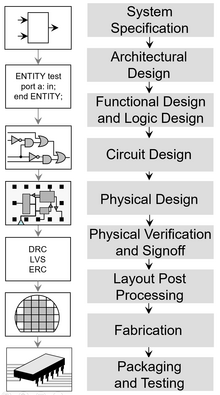एकीकृत परिपथ की डिजाइन
एकीकृत परिपथ की डिजाइन (Integrated circuit design या IC design) इलेक्ट्रॉनिक इंजीनियरी का एक प्रभाग है जिसमें एकीकृत परिपथों की डिजाइन में प्रयुक्त तकनीकों का समावेश होता है।

डिजाइन के चरण
संपादित करें

किसी एकीकृत परिपथ की डिजाइन में अनेकों चरणों से होकर जाना पड़ता है-
- Feasibility study and die size estimate
- Function analysis
- System Level Design
- Analogue Design, Simulation & Layout
- Digital Design, Simulation & Synthesis
- System Simulation & Verification
- Design For Test and Automatic test pattern generation
- Design for manufacturability (IC)
- Tape-in
- Mask data preparation
- Tape-out
- Wafer fabrication
- Die test
- Packaging
- Post silicon validation and integration
- Device characterization
- Tweak (if necessary)
- Datasheet generation (of usually a Portable Document Format (PDF) file)
- Ramp up
- Production
- Yield Analysis / Warranty Analysis Reliability (semiconductor)
- Failure analysis on any returns
- Plan for next generation chip using production information if possible
Roughly saying, digital IC design can be divided into three parts.
- Electronic system-level design: This step creates the user functional specification. The user may use a variety of languages and tools to create this description. Examples include a C/C++ model, SystemC, SystemVerilog Transaction Level Models, Simulink and MATLAB.
- RTL design: This step converts the user specification (what the user wants the chip to do) into a register transfer level (RTL) description. The RTL describes the exact behavior of the digital circuits on the chip, as well as the interconnections to inputs and outputs.
- Physical design: This step takes the RTL, and a library of available logic gates, and creates a chip design. This involves figuring out which gates to use, defining places for them, and wiring them together.
ध्यान दें कि द्वितीय चरण (RTL design) से ही निर्धारित होता है कि चिप सही कार्य करेगी। तृतीय चरण (भौतिक डिजाइन) से परिपथ के कार्य (functionality) पर कोई प्रभाव नहीं पड़ता (यदि ठीक से डिजाइन हो, तो) किन्तु इस चरण का महत्व इस कारण है कि इस चरण से ही निर्धारित होता है कि चिप कितना 'तेज' काम करेगी और इसका खर्च कितना आयेगा।
